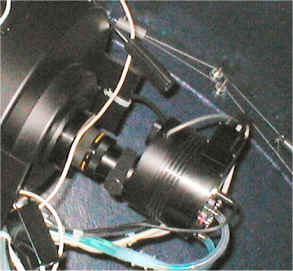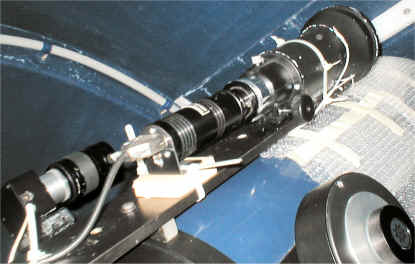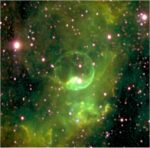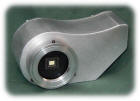Main Menu
|

  
|
When choosing a camera I wanted to play it safe and go for
something established. The
starlight SVX was temping but I ended up buying a second-hand
ST-8 and filter wheel. The
camera has parallel download (not an issue I thought as I would
be watching TV while my automated system download the images)
and the non blue enhanced chip.
My initial sessions with the camera during early autumn
were quite disappointing. I
was only getting the CCD of –5’C and had lots of thermal
noise. So off the
camera went to SBIG for the cooling upgrade.
This gives the camera a second stage of Peltier cooling
and a water heat exchanger.
SBIG recommend an aquarium pump to circulate the coolant.
As these pumps can not pump a great head of water these
only work if there is no air in the system.
I am using a peristaltic pump that is not dependant on a
closed loop. The
coolant is anti freeze, not for its cooling properties but
because it doesn’t freeze in winter!
Now –30’C is achievable most nights and backgrounds a
lot less messy. |
|

|
|
The camera has a built in guide camera.
In order to work a bright star need to be placed in the
CCD. For many
objects the camera would need rotating to get both object and
guide star on there respective CCD’s.
Not so go for automated observing.
I tried using a piggy backed ETX90 with a starlight MX5
as a guide camera but the relatively small aperture and long
focal length again cause problems in finding a guide star.
At the moment I as using a home made copy scope as a
guide scope. This
is made from a lens from a photocopier and a piece of drainage
pipe. The focal
length is only 250mm but coupled with the small pixels of the
MX5 and the sub pixel guide routines its guides the ST8 well and
only needs 2 sec exposures where ever in the sky the scope is
pointing. |
|

|
|
|
|
|
|
|

|
The Poor Meadow Dyke Galleries are now open. THE
GALLERIES |
|

See the full range of Atik cooled CCD cameras for
astronomy on the Atik Website
|
|
|